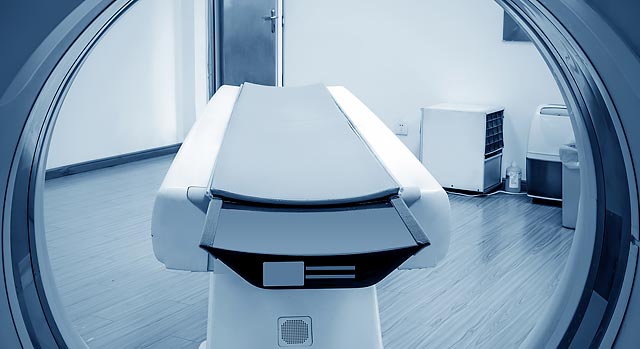Medical Imaging for Detection, Diagnosis and Treatments
Radiology encompasses the area of medicine that utilizes X-rays, radioactive tracers and ultrasonic waves to detect, diagnose and guide treatment of numerous diseases and injuries. Developments in technology, computers and science are advancing the capability to image inner body structures, tissues and organs.
The dynamic images that radiology provides are essential to both physicians and patients, thanks to their realistic depiction of the anatomy, functions and abnormalities within the body. Radiologists can interpret imaging studies, act as consultants to other specialists and perform interventional procedures.
Several imaging procedures are available at Southwest Healthcare Inland Valley Hospital.
Magnetic resonance imaging (MRI)
MRI uses radio waves and a strong magnetic field to create clear and detailed pictures of internal organs and tissues. Since MRI does not use X-rays, no radiation exposure is involved. In MRI, radio waves are directed at the body’s protons within the magnetic field. The protons become “excited” and as they “relax” and emit radio signals, they are then processed by a computer to create an image.
MRI is useful in diagnosing diseases in all parts of the body including cancer, vascular and heart disease, liver and bile duct abnormalities, stroke, other neurological diseases and joint and musculoskeletal disorders.
An MRI exam usually will take anywhere from 30-50 minutes and consists of several imaging series. Most studies will require a small intravenous injection of an MRI contrast agent to help make certain issues more clearly visible.
Interventional radiology
Interventional radiology is a subspecialty of radiology in which physicians perform minimally invasive procedures using imaging equipment. Some of the procedures are for diagnostic purposes while others are for treatment.
Interventional radiology can be used to treat blockages inside arteries and veins, block off blood vessels that nourish tumors, destroy malignant tumors using focused heat and freezing, drain blocked organ systems such as the liver, gallbladder and kidney and perform biopsies that would otherwise require surgical exploration.
Nuclear medicine
Nuclear medicine is used in the diagnosis, management, treatment and prevention of serious disease. Nuclear medicine imaging is often able to identify abnormalities very early in the progression of a disease.
Very small amounts of radioactive materials that are attracted to specific organs, bones or tissues are used in nuclear medicine. These materials emit gamma rays that can be detected externally by special types of cameras working in conjunction with computers to form images.
Ultrasound
Ultrasound, or sonography, uses high frequency sound waves to produce images of the body. A device that acts like a microphone and speaker is placed in contact with the body using ultrasound gel to transmit the sound. As the sound waves pass through the body, echoes are produced and bounce back to the transducer.
These echoes can help doctors determine the location of a structure or abnormality, as well as information about its make up.
Ultrasound is a painless way to examine internal organs such as the heart, liver, blood vessels, breast, kidney or gallbladder, and is most commonly known for its ability to examine a fetus in the mother’s womb. Ultrasound scanning currently is considered to be a safe, noninvasive, accurate and cost-effective investigation of the fetus. It has progressively become a crucial obstetric tool and plays an important role in the care of many pregnant women.
Magnetic resonance angiography (MRA)
MRA is a noninvasive procedure that uses MRI to visualize vessels as two-dimensional and three-dimensional images that can be viewed on a computer monitor. The indications are similar to that of computed tomography angiography (CTA). This noninvasive procedure requires no X-rays, invasive catheter placement or iodinated contrast material, but does involve an intravenous injection of Gadolinium.
MRA is a painless, shorter exam than a catheter angiography. The results of MRA may be used to determine whether surgery or treatment, such as angioplasty, is needed and to plan that treatment.
Computed tomography angiography (CTA)
CTA uses a CT scanner to noninvasively produce images of vessels. Iodine is a contrast material that may be injected into a vein using a small intravenous needle, creating no need for invasive catheter placement. This type of exam has been used to screen numerous patients for arterial diseases such as aortic dissection, carotid stenosis, aneurysms and vascular disease of the kidney.
Most patients can receive this exam without being admitted into the hospital. This method of detection displays the anatomical detail of blood vessels more precisely than an ultrasound, and while comparable to MRI, is faster and can be performed on patients with pacemakers and other metal implants.
Helical (spiral) CT scan
CT scans use special X-ray systems that produce images of the body from different angles, and then use computer processing to show a cross-section of the various tissues and organs pictured. With very little radiation exposure to patients, CT scans have proven very helpful in diagnosing cancer, cardiovascular disease, infectious disease, trauma and musculoskeletal disorders.
Helical (spiral) CT is a vast improvement over conventional CT scans. The patient lies on an exam table that passes through a doughnut-shaped scanner, while an X-ray tube rotates around the table. This movement results in a spiral shaped continuous data set without gaps.
With the helical CT, there is less likelihood to miss small tumors or abnormalities, and spiral CT is about 8-10 times faster than traditional CT. This procedure is especially beneficial to the elderly, very young patients and acutely injured patients who are sensitive to longer exam times.
Find a doctor
For a free physician referral at Inland Valley Hospital, call the referral service 800-879-1020.

